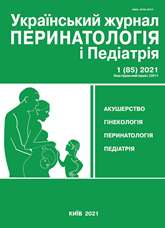Features of the small intestinal atresia clinical manifestation in newborns in the first minutes of their life
DOI:
https://doi.org/10.15574/PP.2021.85.47Keywords:
atresia, small intestine, clinical manifestations, newbornsAbstract
Clinical signs of small bowel atresia, which are widely described in the literature, usually develop after the first day of life. Studies on the clinical manifestations of intestinal atresia in newborns in the first minutes of their lives are still lacking.
Purpose — to identify clinical signs of different types of intestinal atresia which can be detected by physical examination of the newborn, immediately after birth.
Materials and methods. A retrospective study of 77 newborns with congenital small intestinal obstruction (SIO) who underwent surgical management at the Neonatal Surgery Center for Congenital Malformations and their Rehabilitation SI «Institute of Pediatrics, Obstetrics and Gynecology named after acad. E.M. Lukyanova of the NAMS of Ukraine» was conducted. The clinical manifestations of SIO in patients with duodenal (n=44), jejunal (n=14) and ileal (n=19) atresia were studied and a statistical analysis was performed.
Results. There was no significant difference in the volume of gastric stasis, abdominal bloating and meconium discharge in patients with different types of duodenal obstruction (P>0.05). It was found that patients with duodenal and jejunal obstruction, immediately after birth, have a significantly higher volume of gastric stasis (38.0±23.9 ml and 42.3±20.0 ml, respectively) compared with patients who had ileal atresia (14.7±12.8 ml), (P<0.05). There were no significant differences in the incidence of abdominal bloating and meconium discharge (P>0.05).
Conclusions. Duodenal and jejunal atresia are associated with excessive gastrostasis, but meconium discharge may be normal. Abdominal bloating always occurs in duodenal atresia and may be absent in jejunal and ileal atresia. In patients with ileal atresia, there may be no signs of intestinal obstruction immediately after birth.
Level of evidence. Level III.
The research was carried out in accordance with the principles of the Helsinki Declaration. The study protocol was approved by the Local Ethics Committee of an participating institution. The informed consent of the child's parents was obtained from the studies.
No conflict of interest was declared by the authors.
References
Bairov GA, Sitkovskiy NB, Topuzov VS. (1977). Neprohodimost kishechnika u detey. Kiev. Zdorovya: 160.
Dong Ma, Dengming Lai, Xiaoxia Zhao et al. (2019, Jul 25). Therapeutic experience of type III-b congenital intestinal atresia. Zhejiang Da Xue Xue Bao Yi Xue Ban. 48 (5): 487–492.
Fairbanks TJ, Sala FG, Kanard R et al. (2006, Jan). The fibroblast growth factor pathway serves a regulatory role in proliferation and apoptosis in the pathogenesis of intestinal atresia. J Pediatr Surg. 41 (1): 132-136. https://doi.org/10.1016/j.jpedsurg.2005.10.054; PMid:16410122
Holcomb GW III, Murphy JP, JD, Ostlie. (2014). Ashcraft's Pediatric Surgery. 6th ed Philadelphia: Еlsevier saunders: 1040.
Miscia ME, Lauriti G, Chiesa PL et al. (2019, Jan). Duodenal atresia and associated intestinal atresia: a cohort study and review of the literature. Pediatr Surg Int. 35 (1): 151-157. https://doi.org/10.1007/s00383-018-4387-1; PMid:30386906
Morikawa K, Nozaki M, Hirata K et al. (2021, Feb 1). Clostridium tertium Peritonitis and Bacteremia in a Neonate With Congenital Intestinal Atresia: A Case Report. Pediatr Infect Dis J. 40 (2): 159-161. https://doi.org/10.1097/INF.0000000000002920; PMid:33006876
Migur M. (2016). Modern problematic issues of diagnostics and surgical treatment of congenital low intestinal obstruction in neonates (literature review). Perinatologiya i pediatriya. 4 (68): 63-72. https://doi.org/10.15574/PP.2016.68.63
Sandrasegaran K, Patel A, Fogel EL et al. (2009). Annular pancreas in adults. AJR Am J Roentgenol. 193: 455. https://doi.org/10.2214/AJR.08.1596; PMid:19620443
Shawis R, Antao B. (2006). Prenatal bowel dilatation and the subsequent postnatal management. Early Hum Dev: 297-303. https://doi.org/10.1016/j.earlhumdev.2006.02.005; PMid:16626900
Shisong Zhang, Yurui Wu, Hongzhen Liu et al. (2018, May 25). Experience in treatment of complex congenital intestinal atresia in children. Zhejiang Da Xue Xue Bao Yi Xue Ban. 47 (3): 255-260.
Sliepov OK, Migur MYu, Soroka VP. (2016). Modern problems of diagnosis and treatment of congenital duodenal obstruction in newborn infants (literature review). Perinatologiya i pediatriya. 3: 134-140. https://doi.org/10.15574/PP.2016.67.134
Sliepov O, Migur M, Soroka V. (2017). Surgical treatment of congenital jejunoileal obstruction in newborns. Paediatric Surgery.Ukraine. 2 (55): 70-75. https://doi.org/10.15574/PS.2017.55.70
Sliepov OK, Migur MYu, Juravel AO. (2017). Risk factors and their influence on surgical results of congenital jejunoileal obstruction in infants. Perinatologiya i pediatriya. 2 (70): 108-112. https://doi.org/10.15574/PP.2017.70.108
Sliepov O, Migur M, Juravel A. (2017). Risk factors and their influence on the surgical results of congenital duodenal obstruction in infants. Sovremennaya pediatriya. 4 (84): 134-138. https://doi.org/10.15574/SP.2017.84.134
Wax JR, Hamilton T, Cartin A, Dudley J, Pinette MG, Blackstone J. (2006). Congenital Jejunal and Ileal Atresia Natural Prenatal Sonographic History and Association With Neonatal Outcome. Ultrasound Med. 25: 337-342. https://doi.org/10.7863/jum.2006.25.3.337; PMid:16495494
Downloads
Published
Issue
Section
License
The policy of the Journal “Ukrainian Journal of Perinatology and Pediatrics” is compatible with the vast majority of funders' of open access and self-archiving policies. The journal provides immediate open access route being convinced that everyone – not only scientists - can benefit from research results, and publishes articles exclusively under open access distribution, with a Creative Commons Attribution-Noncommercial 4.0 international license(СС BY-NC).
Authors transfer the copyright to the Journal “MODERN PEDIATRICS. UKRAINE” when the manuscript is accepted for publication. Authors declare that this manuscript has not been published nor is under simultaneous consideration for publication elsewhere. After publication, the articles become freely available on-line to the public.
Readers have the right to use, distribute, and reproduce articles in any medium, provided the articles and the journal are properly cited.
The use of published materials for commercial purposes is strongly prohibited.

